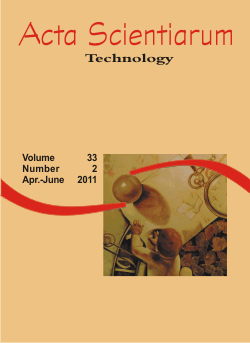<b>Study of aqueous pectin solutions microfiltration process by ceramic membrane</b> - doi: 10.4025/actascitechnol.v33i2.7000
DOI:
https://doi.org/10.4025/actascitechnol.v33i2.7000Keywords:
crossflow microfiltration, pectin, fouling, resistances in series modelAbstract
In this work, pressure effects, separation efficiency and resistive effects of microfiltration of pectin solution were investigated. Stabilized permeate flux values were obtained for solutions concentrations of 1.0 and 2.0 g L-1 under different pressure conditions of 0.4, 0.8, 1.2 and 1.6 bar. A full factorial design with two levels was applied to evaluate the effects of the pressure, temperature and concentration in the process resistances. The experiments were performed in a crossflow microfiltration system with multitubular membrane with nominal pore size of 0.44 µm and feed flow of 1.0 m³ h-1. Pectin retention coefficients and process resistances were obtained following the resistances in series model. It was observed that the highest values of permeate flux for concentration solution of 1.0 and 2.0 g L-1 were at pressure of 1.2 and 0.8 bar, respectively, however, the lowest obtained permeate flux were at 1.6 bar. The permeate flux and the polarization resistance increased, respectively, with increasing temperature and concentration. The results showed that the lowest value of the retention coefficient was 93.4% and the most significant resistance was due to fouling. The highest value of resistance was 4.13 x 109 m² kg-1 at temperature of 30°C and concentration of 2.0 g L-1.Downloads
Download data is not yet available.
Downloads
Published
2011-02-23
How to Cite
Silva, V. R. da, & Scheer, A. de P. (2011). <b>Study of aqueous pectin solutions microfiltration process by ceramic membrane</b> - doi: 10.4025/actascitechnol.v33i2.7000. Acta Scientiarum. Technology, 33(2), 215–220. https://doi.org/10.4025/actascitechnol.v33i2.7000
Issue
Section
Food Technology
License
DECLARATION OF ORIGINALITY AND COPYRIGHTS
I Declare that current article is original and has not been submitted for publication, in part or in whole, to any other national or international journal.
The copyrights belong exclusively to the authors. Published content is licensed under Creative Commons Attribution 4.0 (CC BY 4.0) guidelines, which allows sharing (copy and distribution of the material in any medium or format) and adaptation (remix, transform, and build upon the material) for any purpose, even commercially, under the terms of attribution.
Read this link for further information on how to use CC BY 4.0 properly.











8.png)




